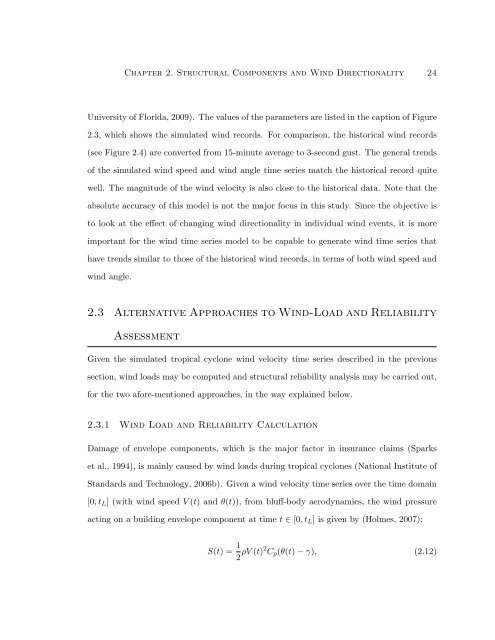Wind Hazard Risk Assessment and Management for Structures
Wind Hazard Risk Assessment and Management for Structures
Wind Hazard Risk Assessment and Management for Structures
Create successful ePaper yourself
Turn your PDF publications into a flip-book with our unique Google optimized e-Paper software.
Chapter 2. Structural Components <strong>and</strong> <strong>Wind</strong> Directionality 24<br />
University of Florida, 2009). The values of the parameters are listed in the caption of Figure<br />
2.3, which shows the simulated wind records. For comparison, the historical wind records<br />
(see Figure 2.4) are converted from 15-minute average to 3-second gust. The general trends<br />
of the simulated wind speed <strong>and</strong> wind angle time series match the historical record quite<br />
well. The magnitude of the wind velocity is also close to the historical data. Note that the<br />
absolute accuracy of this model is not the major focus in this study. Since the objective is<br />
to look at the effect of changing wind directionality in individual wind events, it is more<br />
important <strong>for</strong> the wind time series model to be capable to generate wind time series that<br />
have trends similar to those of the historical wind records, in terms of both wind speed <strong>and</strong><br />
wind angle.<br />
2.3 Alternative Approaches to <strong>Wind</strong>-Load <strong>and</strong> Reliability<br />
<strong>Assessment</strong><br />
Given the simulated tropical cyclone wind velocity time series described in the previous<br />
section, wind loads may be computed <strong>and</strong> structural reliability analysis may be carried out,<br />
<strong>for</strong> the two a<strong>for</strong>e-mentioned approaches, in the way explained below.<br />
2.3.1 <strong>Wind</strong> Load <strong>and</strong> Reliability Calculation<br />
Damage of envelope components, which is the major factor in insurance claims (Sparks<br />
et al., 1994), is mainly caused by wind loads during tropical cyclones (National Institute of<br />
St<strong>and</strong>ards <strong>and</strong> Technology, 2006b). Given a wind velocity time series over the time domain<br />
[0, tL] (with wind speed V (t) <strong>and</strong> θ(t)), from bluff-body aerodynamics, the wind pressure<br />
acting on a building envelope component at time t ∈ [0, tL] is given by (Holmes, 2007):<br />
S(t) = 1<br />
2 ρV (t)2 Cp(θ(t) − γ), (2.12)
















